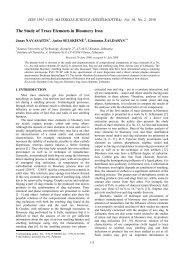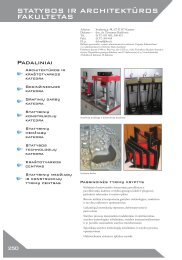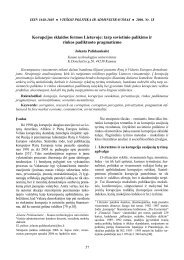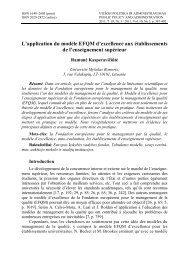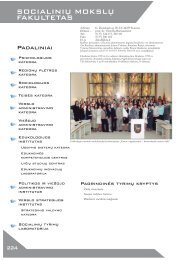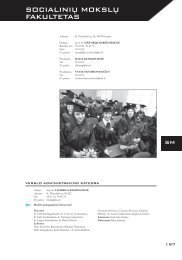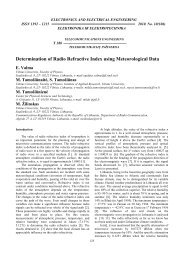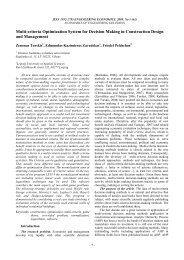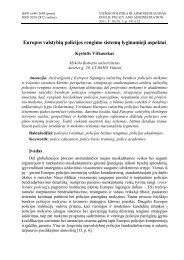CUSTOMER SERVICES - A PART OF MARKET ORIENTATION
CUSTOMER SERVICES - A PART OF MARKET ORIENTATION
CUSTOMER SERVICES - A PART OF MARKET ORIENTATION
Create successful ePaper yourself
Turn your PDF publications into a flip-book with our unique Google optimized e-Paper software.
ISSN 1822-6515 ISSN 1822-6515EKONOMIKA IR VADYBA: 2010. 15 ECONOMICS AND MANAGEMENT: 2010. 15<strong>CUSTOMER</strong> <strong>SERVICES</strong> - A <strong>PART</strong> <strong>OF</strong> <strong>MARKET</strong> <strong>ORIENTATION</strong>Lucie KaňovskáBrno University of Technology, Czech Republic, kanovska@fbm.vutbr.czAbstractThe aim of this paper is to present the importance of customer services as a part of market orientationfrom both the theoretical view and by selected results of the survey of Hi-Tech firms in the Czech Republic.The research was particularly focused on a customer. The first part of the paper briefly describes the maincharacteristics of customer services from the customers’ view. The second part is focused on survey of Hi-Tech companies. The results from the research show that management of companies is usually aware of theimportance of customers’ satisfaction and of the quality supply of customer services as well. Customerservices are widely seen as a necessity for today’s survival on the market. The paper is written in theframework of research project “Research on implementation on market orientation in High-Tech Firms”supported by Grant Agency of the Czech Republic (GA 402/07/1493).Keywords: marketing, customer services, market orientation, Hi-Tech company, the Czech Republic.IntroductionEvery company should know customers’ needs and mostly they claim they know. However the abilityto provide a final product according to the expectations can be questionable. All company activities such asmanufacturing, sales and customer services as well should ensure customer satisfaction. Therefore customerservices are always very important and topical, because they can help to increase customer satisfaction withthe product using. Services can be seen as a source of company profit and possible differentiation, too.Almost all companies have to be providers of customer services today. Moreover focusing on customers, e.g.providing customer services, is one of the main benefit of well done application of market orientation in acompany. Market orientation is one of the key trends in the field of marketing today. The core elements ofmarket orientation are its focus on the customer, focus on competitors, the setting up of long-term objectives,coordination of marketing activities and, last but not least, the importance of a good quality system ofbusiness intelligence.The aim of this paper is to present the importance of customer services as a part of market orientationfrom both the theoretical view and by selected results of the survey of Hi-Tech firms in the Czech Republic.The methodology of the paper is issued from the research project titled “Research on implementationon market orientation in Hi-Tech Firms”. In the research part of the GACR project mentioned, two differentquestionnaires are used (see more bellow). For the paper were used data from measurement of marketorientation only.Customer servicesCustomer services are all what company does for satisfaction of its customers. They help to gainhigher profit from sold products. According to Bovée & Thill (1992), quality and customer services presentstrong barrier against the competition, ensure customer loyalty; help to differentiate product and decreasemarketing costs and increase company profit.Nowadays industrial producers are becoming providers of customer services too. This situation helpsto extend their activities for customers. In fact profit from provided customer services can be gained both forcustomers and also for companies. Many customers make final purchasing decision not only according to theproduct price, but also according to the range and level of customer services related to the product. Thecompanies which try to hold dominant position in provided customer services are forced to determinate andevaluate specific needs of their market segment and adapt their company strategy for them. Most ofcompanies working in different spheres of economy know very well that strategy of differentiation on thebasis of special and “customized” services can be seen as an important opportunity to avoid a price war withcompetitors. Therefore, customer services become an integral part of searching for competition advantages ina wide range of economic spheres. There are some possible reasons concerning the above tendency, whichmay be mentioned here: flattening of demand in traditional production, increasing of internationalcompetition, a short life cycle of product innovations and important profit potential of services.The perception of the term customer service was changing over the years, see Table 1. At thebeginning services were seen as an integration tool for intradepartmental activities (the definitions from562
ISSN 1822-6515 ISSN 1822-6515EKONOMIKA IR VADYBA: 2010. 15 ECONOMICS AND MANAGEMENT: 2010. 15LaLonde & Zinser, 1976 or Rinehart et al., 1989). Then marketing view of services has started to achievemaximum effort to satisfy customers. Also services can add value to product. It is involved in the definitionsfrom Bovée & Thill, 1992, Horovitz, 1994, Amico & Zikmund, 2001 or Kotler, 2001. Also logistic view ofcustomer services increases their role to assure product delivery from producer to customer. This view isseen by Horáková & Kubát (1999) or Christopher (2000). The last view, the current one, has the key roleconnected with relationship with customers, see in definition by Lehtinen (2007).AuthorLaLonde &Zinser (1976)Rinehart et al(1989)Bovée & Thill(1992)Horovitz (1994)Amico & Zikmund(2001)Kotler (2001)Horáková andKubát (1999)Christopher(2000)Lehtinen (2007)Table 1. Perception of customer servicesView and definition of customer servicesIntegration tool for intradepartmental activitiesServices are the kind of activities between the organization and customers to improve or simplifysale and using of products. They involve also operations of producers provided for customersduring the whole transaction.Services are common factor for integration of marketing and logistics.Marketing viewServices involve all what organization makes for satisfaction of their customers and help to realizeas big advantage as possible from products bought by customers. Services are activities which canadd the value to products.Services are complex of promises which are expected from the product by a customer, as functionof price or image.Services present company activities created to increase value of selling products to strengthencustomer satisfaction.Services involve all aspects of mutual relationships among producers, distributors and customers.Logistic viewServices present important activities from the purchase order of customer to delivery of products.The activities are customer-oriented and depend on the kind of product and type of customer.Services are the system organized to assure continuity between the time of purchase order anddelivery of goods. The aim is to satisfy customer needs from the long-lasting view.Relationship with customersServices are all activities connected with assuring relationship with customer – from productdelivery to different ways of help by its using.Perception of customer services shows the differences changes during years and confirms currenttendency to be in a very deep touch with customers. It means to have a long-term relationship with clienteleas well. Focus on customers is also one of main parts of market orientation. Market oriented companies aremainly focused on customers, suppliers, competitors and distributors (see Table 3). Customers are usuallyevaluated as the most important stakeholders. Therefore companies generally pay high attention to them.Examples of customer services in Hi-tech companiesCustomer services are often the last or even the first step in the process of considering the purchase ofa new product. Therefore it is very important to spend a long time to prepare and implement the strategy ofcustomer services, involving their supply for different customer segments on market.Customer services provided by hi-tech companies can be the following ones: cooperation on R&D of aproduct, its innovation and production, consultancy before and after sale, sufficient information aboutproduct involving deep technical information. We should mention payment conditions, transport, packagingand assembling of products according to customer requirements, after-sale services (such as replacement ofspare parts and also customer training for the first use and on regular bases as well), etc.Indeed the fulfilling of customers’ needs is very individual in each company. Finally customerservices should be managed according to customer expectations. In Hi-Tech companies, the customer is inthe centre of attention and customer satisfaction becomes the priority.Research design and methodologyThe second part of the paper is focused on the brief overview on the research held in Hi-Techcompanies in the Czech Republic. The research project was titled as “Research on implementation on market563
ISSN 1822-6515 ISSN 1822-6515EKONOMIKA IR VADYBA: 2010. 15 ECONOMICS AND MANAGEMENT: 2010. 15orientation in Hi-Tech Firms” and two different questionnaires were used. The data from measurement ofmarket orientation, part: focus on customers, was only used for the paper. The data were gathered during thefirst half of 2009 for the project. The questionnaire constituted by Tomášková (2005) along with the “NewMethod” of the market orientation measuring was used. The 7 point Likert scale was used (0 – highlydisagree, 7 – highly agree).The “New Method” includes external environment elements, branch environment elements andinternal environment elements of a company. The surveyed sample consisted of companies classified as hitechcompanies according to the CZ NACE codes utilized by the Czech Ministry of Industry and Trade. Forthe purposes of the research project, manufacturing companies operating mainly in mechanical and electricengineering sectors (NACE codes 3x xxx) were selected. The database of the Kompass Czech RepublicCompany was used to make the selection.A total of 450 firms were included into the main research. The companies were contacted over thephone line and asked to personally participate in the survey, or to fill in a questionnaire in electronic formaton the Internet. The data from the questionnaires were converted to electronic format and loaded to a specialdesigned programme where they were analyzed by standard statistical methods as well as other sophisticatedtechniques. Incomplete data gathered by the questionnaires were discarded when checked. Data from only 88companies were used for further processing.ResultsThe problem connected to customer services was in the part of questions related to end users(customers) in the questionnaire constituted by Tomášková (2005), see above. The statements related tocustomers are seen in Table 2. Customers are a part of the branch environment elements, see in Table 3.The highest rate, not only in the section about end users (customers), but in the whole elements ofquestionnaire (external environment, branch environment and internal environment of a company), receivedstatement with number 3 “We use individual approach to our customers”. The average value was 6,34(SD±0,858). The statement with number 4 from the section about end users “We offer wide range of aftersalesservices” gained average value 5,17 (SD±1,565). The table 3 shows average values of branchenvironment elements.Table 2. Average values of statements related to end users(0 – highly disagree, 7 – highly agree)Statement in questionnaireMean1. We regularly analyze factors which influence sale behaviour of our customers. 5,212. We regularly monitor the requirements of current and potential customers. 5,773. We use individual approach to our customers. 6,344. We offer wide range of after-sales services. 5,175. We regularly find out the rate of satisfaction of final customers 5,536. We know the image of our products from our customers. 5,587. We find out why potential customers did not buy our products. 4,64The results mentioned in the Table 2 confirm (statement no. 3) the importance of the individualapproach to customers as one of the most important step in today’s business. Focusing on customer usingindividual supply and services is the most important benefit of market orientation.The value of supply of customer services is not as high as statement in number 3, however it isrelatively high number and services are seen positively by company management. In conclusion, there can bestill some possibilities how to improve the supply of services. It is a good idea to try to find out customerexpectations and then compare with their perception of used services.Table 3. Average values of market orientation, part branch environment elements(0 – highly disagree, 7 – highly agree)Branch environment elementsMeanEnd users (customers) 5,47Distributors 5,06Competitors 4,82Suppliers 4,74564
ISSN 1822-6515 ISSN 1822-6515EKONOMIKA IR VADYBA: 2010. 15 ECONOMICS AND MANAGEMENT: 2010. 15From the Table 3 it is clear that orientation on the group of end users (customers) and distributorsreceived the highest value as it was mentioned in a theoretical part about customer services. Customers arealways seen as the most important stakeholders.ConclusionsThe lowest average value reaches the statement referring to the reasons why potential customers did notbuy companies’ products. The clue is probably in lack of company interest in searching for potential clients.Managers are more focus on current customers than not on potential ones. This is visible also from the resultfrom statement relating to the individual approach to customers, which confirms high concentration oncurrent customers and their individual needs However reasons why potential clients deny company productscould help company to extend their activities and product supply, increase employee motivation, or just toknow more about competitors and their strategies. It is very stimulating to know about customer perceptionon company products, customer services or even whole company. Even if they are potential ones.Customer services are seen as a necessity not only for Hi-Tech firms. Almost every company providesat least one possible customer service to its clients. The most used services are connected with after-saleservices, transport and training, especially in B2B. It is easy to recommend spending more time and effort forthe extension of wider and more attractive services in Hi-Tech firms, according to the survey. However itcould be complicated and long-time process sometimes. The reasons for the difficultness in this can be asfollow: lack of motivation to improve current situation, lack of interest to find out exactly what customersneed. A motor should lay in never-ending effort to be always in front of competitors as well. Not only pricesand technical criteria play a key role in decision making process during the purchasing of a new product. Themore positive points have customers about potential products, the more probable is their effort to buy them.References1. Amico, M.D`.,& Zikmund, W. G. (2001). The power of marketing. Creating and keeping customers in an e-commerce world. 7th edition. Cincinnati: South-Western College Publishing..2. Bovée, C. L., & Thill, J. V. (1992). Study guide to accompany Marketing, McGraw-Hill.3. Christopher, M. (2000). Logistika v marketingu. 1 st edition. Praha: Management Press .4. Horáková, H., & Kubát, J. (1999). Řízení zásob. Logistické pojetí, metody, aplikace, praktické úlohy. 1. edition.Praha: Profess Consulting.5. Horovitz, J. (1994). Jak získat zákazníka. Kvalita služeb. 1 st edition. Praha: Management Press.6. Kotler, P. (2001). Marketing. Management.10th edition. Praha: Grada Publishing.7. Lalonde, B.J., & Zinszer, P.H. (1976). Customer Service: Meanings and Measurement. National Council ofPhysical Distribution Management. Chicago, IL.8. Lehtinen, J. R. (2007). Aktivní CRM. Řízení vztahů se zákazníky. 1st edition. Praha: Grada Publishing.9. Rinehart, L.M., Cooper, M.B., & Wagenheim, G.D. (1989). Furthering the integration of marketing and logisticsthrough customer service in the channel. In: Journal of the Academy of Marketing Science, Vol. 17, Iss. 1, (pp. 63-71).10. Tomášková, E. (2005). Měření tržní orientace a její vliv na podnikový výkon. Brno: Vutium.565



